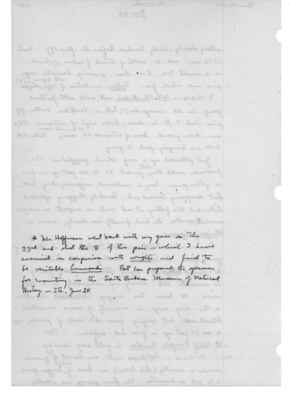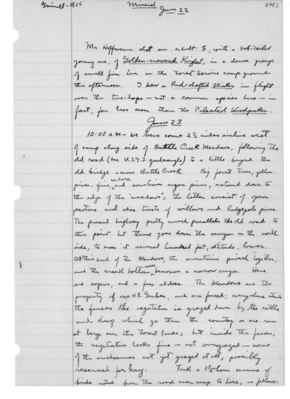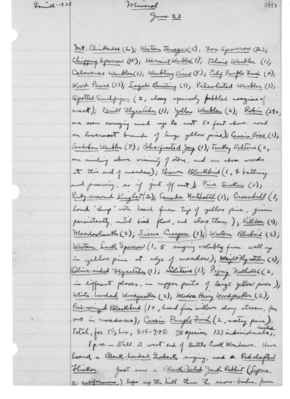Pages
S2 Page 35
Collector: Grinnell - 1925 Location: Unspecified (but presumably either proximate to Mineral or having left for elsewhere). Date: June 24 Page Number: No formal page #.
* Mr. Hoffmann went back with my gun on the 23nd and shot the male of this pair - which I have examined in comparison with wrighti and find to be veritable hammondi. Rett has prepared the specimen for mounting in the Santa Barbara Museum of Natural History - J. G., June 24.
S2 Page 36
Collector: Grinnell - 1925 Location: Mineral Date: June 22 Page Number: 2490
sheltered within the cavity, the nest being in-set in bark and needle floor right against the charcoal wall. Rim of nest (exposed side) marked by coarse pine twigs and needles, scattering out towards opening of cavity; latter 600 mm. high at peak, 480 mm. wide at base of opening; rim of nest a little higher, about 25 mm., than ground in front. Nest found by watching old birds, with food perching around quietly on stubs of fallen logs and lower branches of big standing trees, finally flying down to side. The yellow thickened corners of mouth and edges of bill loom up a most conspicuous feature of young in shade of cavity. On dry ridge top, open forest of white fir, cedar, yellow and sugar pines.
Saw a Sharp-shinned Hawk in flight from direction of camp, well above tree-tops. One or both of a pair of Evening Grosbeaks were noted repeatedly in a certain section of the woods. Mr. Hoffmann discovered a Hammond(*) Flycatcher's nest^(5500 ft. alt.) fully 90 ft. up on a horizontal sub-branch of a huge sugar pine - of course inaccessible. The birds looked ^at that range and sounded, to me, indistinguishable from the "Wright" Flycatchers I have been getting down here with low brush-built nests. However, only shooting of the birds can settle their identity. I saw one of Hoffman's birds come clear to the ground and flit about in small firs and low snow-brush; yet both of the birds did a lot of foraging fully 100 feet up, in firs and pines.
S2 Page 37
Collector: Grinnell - 1925 Location: Mineral Date: June 22 Page Number: 2491
Wright Flycatcher's nest, near camp (75 ft. uphill from), with 4 young hatched on 14th; found with opaque eggs two days previously by Dixon and, I think, photographed by him. Rim of nest 1500 mm. above ground, nest (of usual construction and gray color, ensconced among pendent twigs were [sic] a slender branch from each of two adjacent red cherry bushes one another, and one of these has an unhealthy outgrowth of leafage looking like mistletoe. Nest within to feet, one east side, of 24-inch trunk of yellow pine; snow bushes nearby, and firs within 20 feet; site practically where a tract of timber and a hillside tract of open snowbush adjoins. Male fed young at 3:12 and 3:16, he not being, apparently, alarmed at us, as is female which was brooding when we came. Female continues to utter a faint "peet" of concern; male from overhead says "see-put" (uttered very rapidly); when male alighted on edge of nest to feed, he gave a short musical trill of short duration and weak in volume. Female keeps close to nest, perching on twigs within a radius of 4 feet. She perches on edge of nest; leaves; returns and settles down to brood, continuing to say "peet", but more faintly. 3:30 - [female symbol] still brooding and saying "peet" very faintly and not so frequently. 3:35 - (female) still brooding, tho nest is in shade of pine trunk: has ceased to say "pit."
S2 Page 38
Collector: Grinnell - 1925 Location: Mineral Date: June 22 Page Number: 2492
Mr. Hoffmann shot an adult male, with a bob-tailed young one, of Golden-crowned Kinglet, in a dense group of small fir here on the Forest Service camp ground this afternoon. I saw a Red-shafted Flicker in flight over the tree-tops - not a common species here - in fact, far less seen than the Pileated Woodpecker.
June 23 10:00 a.m. - we have come 2 1/2 miles airline west of camp along side of Battle Creek Meadows, following the old road (see U.S.G.S quadrangle) to a little beyond the old bridge across Battle Creek. Big forest trees, yellow pines, fir, cedars, and sometimes sugar pines, extend down to the edge of the "meadows"; the latter consist of open pasture and also tracts of willows and lodgepole pines. The present highway pretty much parallels the old road to this point but thence goes down the canyon on the north side, to cross it several hundred feet, altitude, lower. At this end of the Meadows, the mountains pinch together, and the creek bottom ^soon becomes a narrow canyon. Here are aspens, and a few alders. The Meadows are the property of one W. L. Gerber (?), and are fenced; everywhere astride the fences the vegetation is grazed down by the cattle and sheep which go thru [sic] the country or are seen at large over the forest lands; but inside the fences, the vegetation looks fine - not overgrazed - some of the enclosures not yet grazed at all, possibly reserved for hay. Took a 1 1/2 hour census of birds notes from the road near camp to here, as follows:
S2 Page 39
Collector: Grinnell - 1925 Location: Mineral Date: June 23 Page Number: 2493
Mt. Chickadee (2); Western Tanager (5); Fox Sparrow (2); Chipping Sparrow (18); Hermit Warbler (3); Tolmie Warbler (1); Calaveras Warbler (1); Warbling Vireo (8); Calif. Purple Finch (4); Wood Pewee (13); Lazuli Bunting (3) Pileated Warbler (1); Spotted Sandpiper (2, along sparsely pebbled margins of creek); Traill Flycatcher (1); Yellow Warbler (2); Robin (29+, one seen carrying mud up to nest 50 feet above and on lowermost branch of huge yellow pine); Cassin Vireo (1); Audubon Warbler (7); Blue-fronted Jay (1); Turkey Vulture (2, one circling above vicinity of store (?), and one above woods at this end of the meadow) Brewer Blackbird (1, [female symbol] bathing and preening, as if just off nest); Pine Siskin (1); Ruby-crowned Kinglet (2); Canada Nuthatch (1); Crossbill (1, loud "chup" note heard from tips of yellow pine, given persistently, until bird flew, and also then); Killdeer (2); Meadowlark (2); Sierra Creeper (1); Western Bluebird (2); Western Lark Sparrow (1, [male symbol] singing volubly from well up in yellow pine at edge of meadow); Wright Flycatcher (2); Olive-sided Flycatcher (1); Solitaire (1); Pygmy Nuthatch (2, in different places, in upper parts of large yellow pines); White-headed Woodpecker (2); Modoc Hairy Woodpecker (2); Red-winged Blackbird (1+, heard from willows along stream, far out in meadows); Cassin Purple Finch (2, mating pair).
Total, for 1 1/2 hrs., 8:15-9:45: 38 species, 133 individuals.
1 p.m. Still at west end of Battle Creek Meadows. Have heard a Black-headed Grosbeak singing, and a Red-shafted Flicker. Just saw a Black-tailed Jack Rabbit (Lepus c. californicus) lope up the hill thru the snow bushes, from




